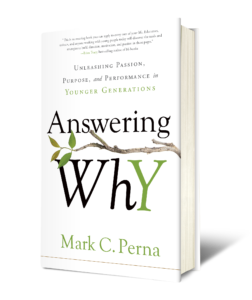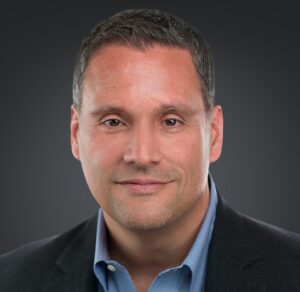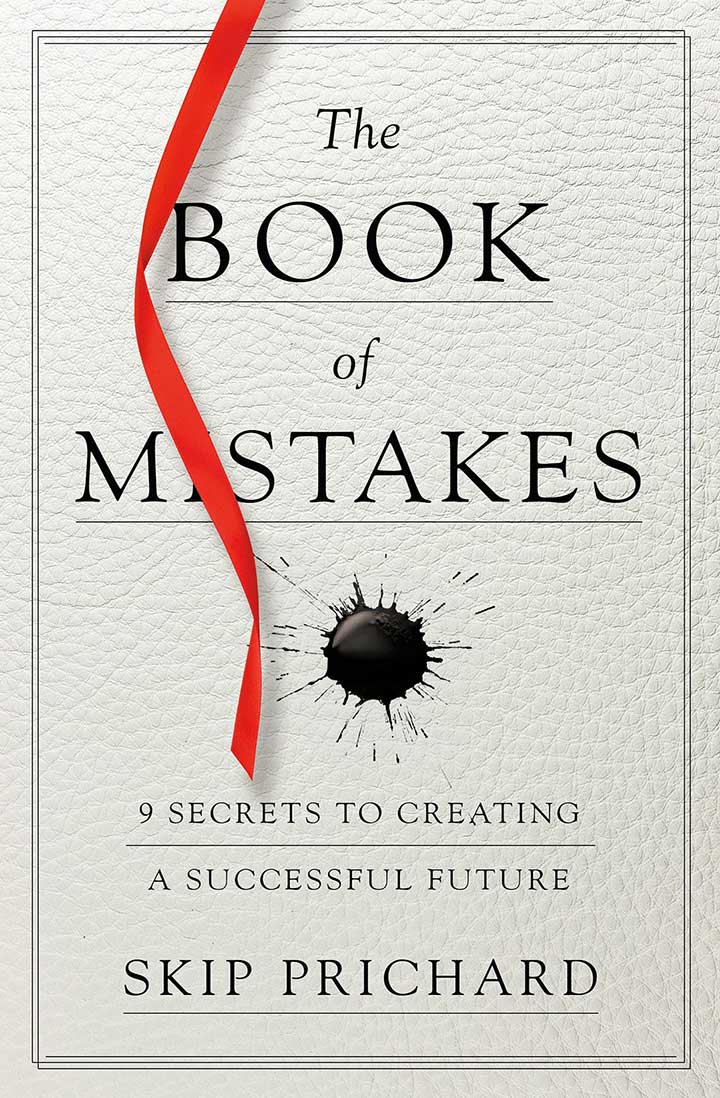Future Leaders
Over one hundred million people make up millennials and Generation Z.
How do we motivate these young people? How do we unleash the power of these new generations?
Mark Perna is an author, CEO and generational expert. His new book Answering Why: Unleashing Passion, Purpose and Performance in Younger Generations, is designed to help leaders awaken the potential of the Why Generation. I recently had the opportunity to ask him about his research and new book.
The Why Generation
What is the Why Generation? What qualities and traits distinguish it?
The Why Generation is my term for Generations Y and Z, which include basically everyone under 40 today. Collectively, I call them the Why Generation because they want to know the reason behind everything. And this is exactly how we reared them. A lot of older-generation folks in management roles often perceive this as disrespect or insubordination, but it’s actually not. Young people want to know the reason why so that they can fully understand what they are being asked to do, and even more than that, so they can see if there is a way they can improve the process. They want to bring their own unique, special, and important contribution to the success of the plan, whatever it may be. They want to be engaged; they want their work to be relevant and mean something. They are not being rebellious when they ask why; they really want to know. They want purpose, and they will perform to the expectations we set for them (whether high or low). We have to answer the big question they are always asking in one way or another: why?
They place great importance on their personal values, which are often characterized by social and environmental activism. They want to be part of something bigger than themselves, and once they buy into a cause, they’re committed. Every decision they make is influenced to some extent by how it affects their desired lifestyle.
They’ve brought a fresh perspective to the working world. Both the Millennials and Generation Z want their work to be about more than the paycheck. They prioritize a flexible working environment that allows them to work from home and/or work nontraditional hours, and many companies are taking these preferences into consideration. They also want to rethink the ways things have always been done to create new processes to complete the work more efficiently.
They’re also digital natives who have grown up surrounded by technology. It’s their norm to have multiple screens going as they maximize their digital experience. Because they believe they’re unique, special, and important, they are constantly looking for ways to tell their story on the vast array of social media options. They also communicate differently, much more briefly than older folks are used to.
In what ways can we realize the full potential of the Why Generation?
The first thing we need to do is rid ourselves of the negative stereotypes that may be lingering in the back of our minds about these generations. The Millennials especially have gotten a bad rap as entitled, lazy, etc., and it’s just not the case for the vast majority. If we can free our minds from these preconceived ideas about the Why Generation, we can then see why they have the potential to be our next “greatest generation.” They’re tenacious. They’re smart. They’ve been reared for achievement, and when they see a compelling reason to put forth that effort, they can achieve almost anything. Our challenge is getting them to want something that badly.
In the workplace, we also need to realize that generational differences are a huge factor in how people of different ages view the world and their place in it. Employers who adapt to the inquisitive nature and desire for purpose on the part of the Why Generation will be able to attract and retain the top talent in this generation. Those who insist on maintaining the status quo will falter in today’s new economy. It’s just the way things are shifting.
Unleashing the full potential of the Why Generation starts with bridging what I call the Awareness Gap. This is the gap between what people think they know or assume about certain careers and industries and what the true reality is. There are so many rewarding careers available today that no one is pursuing because they simply are not aware of those opportunities.
That’s why we need to prioritize career exploration as a cornerstone of a fully rounded education. Students at all levels should be encouraged to pursue Education with Purpose® so that they can achieve Employment with Passion. This will motivate them to seek out (and complete) the education and training that will make them successful in their chosen field.
We also need to move away from the notion that college is the only way to win—there are incredible career opportunities in many high-paying fields that require a certificate or credential, not a four-year degree (that often comes with a load of debt). And we have to help college-bound students truly determine their career direction so they can finish the degrees they start and meet the pressing needs of our economy.
The 1:2:7 Ratio
What is the 1:2:7 ratio and will it ever change?
The 1:2:7 ratio shows that there simply are not enough degree-requiring jobs in the economy to support the ever-increasing number of college graduates. A friend of mine, Dr. Kevin Fleming, put out a viral video called “Success in the New Economy” that I’ll quote here: “The true ratio of jobs in our economy is 1:2:7. For every occupation that requires a master’s degree or more, two professional jobs require a university degree, and there are over half a dozen jobs requiring a one-year certificate or two-year degree; and each of these technicians are in very high-skilled areas that are in great demand.”
This ratio holds true over all industries and is not going to change. Not only that, but colleges are failing to align their offerings with the pressing needs of business and industry, so they often aren’t teaching the skills that employers are looking for. So we have many people heading off to college thinking that a viable, living-wage job will magically appear for them after graduation, and it just isn’t happening.
Create a Clear Roadmap for Success
What advice do you have for organizational leaders? What do they need to know to have the edge of recruiting and retaining this generation?
Creating a clear roadmap for success within the organization is critical. Young people will be motivated if they see the opportunities that are there for the earning. The biggest motivator is a strategy I call the Light at the End of the Tunnel. The light is the goal, the reason for going through the tunnel, which is the work and effort required to reach that goal. Young people need to see that light at the end of their tunnels so they are motivated to push through and keep going until they reach it. They can achieve great things, but they often need the steps clearly laid out so they can experience a sense of accomplishment at the completion of each step.
Because of how they were reared, they are looking for frequent feedback. Recognition and a supportive work environment are also important. The Why Generation wants bosses to be more like mentors and coaches. The younger generations not only seek and thrive on mentorship, but in many ways they expect it. Many of them have been extensively coached in sports and other activities from a young age, and in their minds it’s a logical progression to have a workplace mentor. Managers who see themselves as coaches and welcome that dynamic in the workplace will be effective with the Why Generation.
Organizations should also focus on helping younger workers develop valuable soft skills (or, as I call them, Professional Skills) like work ethic, communication, ability to accept feedback, confidence, leadership, flexibility, integrity, work-life balance, punctuality, stress management, and many more. We have a whole generation of workers who struggle in these areas because these critical skills are simply assumed and have not been intentionally integrated within the learning/training experience.
Finally, the Why Generation wants to work for companies that align with their personal values and priorities of environmental consciousness, social responsibility, etc. If a company does not have a vision and culture focused on doing something positive for the community, today’s younger generations are much less likely to want to invest their time, energy, and career there. And if they do work there, they are much more likely to jump ship and find a new position at the earliest opportunity.
Today’s young people can be more than employees; they can be tremendous allies in the pursuit of heightened organizational performance. But this will only happen if they buy in to the destination. Each workplace will need to adapt to this reality—whatever that looks like in their context. Purpose and vision will drive their success.
Advice for Parents
How about advice for parents raising children in this environment?
I’m a father to two amazing young men who are part of the Millennial generation (or as I call them, the Why Generation) and I know parenting today is not easy. One of my sons, Nick, is extremely smart but struggled in school because he never understood why school mattered, or the relevance of academics. That all changed the minute he toured a computer programming career program and discovered what he wanted to do with the rest of his life. Suddenly he realized he needed to boost that 1.5 GPA to get into college and get the degree he needed to pursue his newfound dream. Amazingly, he turned his lackluster performance around and achieved his goal. He’s working in his field today and loves what he does. When he discovered his passion, it was transformative.
What I learned from Nick is this: As parents, we have to support our child’s desire to understand why. We have to help them find the answers and discover what they’re passionate about so they can perform at a higher level not just in school, but in every area of life. This may mean exploring careers and industries that are outside our own experience, to see if they would be a good fit for our children. I find a lot of parents simply don’t know what they don’t know about the vast opportunities in so many industries today, because they simply haven’t been exposed to these fields. So let’s start having these conversations with our kids, keeping them as low pressure as possible, and explore these things together.
Tell us more about the Career Tree®.
The Career Tree is a refreshing alternative to hundreds of pathways, ladders, flow charts, and other complex metaphors and diagrams that have made education and training pathways challenging to understand.
The branch system of the Tree is split into three equal horizontal sections. The first level, nearest the trunk, is the “Entry-Level Careers,” representing all the careers and occupations that are unlocked immediately following completion of the program of study, or trunk. “Entry-Level” is not synonymous with “low paying,” as many can earn a viable living wage depending on the industry and program of study. The term simply refers to the kinds of careers and occupations that are possible right away without any additional education, training, certifications, or licensure required.
 The middle third of the branch system is called the “Technical Careers,” which represent all the careers and occupations that students can unlock by obtaining further education such as advanced certifications, apprenticeship completion, specialized training, or a two-year associate degree.
The middle third of the branch system is called the “Technical Careers,” which represent all the careers and occupations that students can unlock by obtaining further education such as advanced certifications, apprenticeship completion, specialized training, or a two-year associate degree.
The top third of the branch system is called the “Professional Careers.” This level represents all the careers and occupations that are unlocked by obtaining further education, such as a four-year baccalaureate degree, a master’s degree, a PhD, or some type of specialized training.
Though today the Career Tree is most heavily used in middle and high schools and community colleges, it is also highly applicable in the world of business. It creates an ongoing dialogue that gets young people thinking about their future and what they want to do. This is all a collaborative experience where employees are openly talking about their plans and learning from each other, in what I call a planning culture. The Tree helps connect their passions and lifestyle aspirations with their performance, by connecting the dots between today’s effort and tomorrow’s reward. In short, it brings relevance to their training and career pathway by answering why they need to work hard.
For more information, visit Answering Why: Unleashing Passion, Purpose and Performance in Younger Generations.


